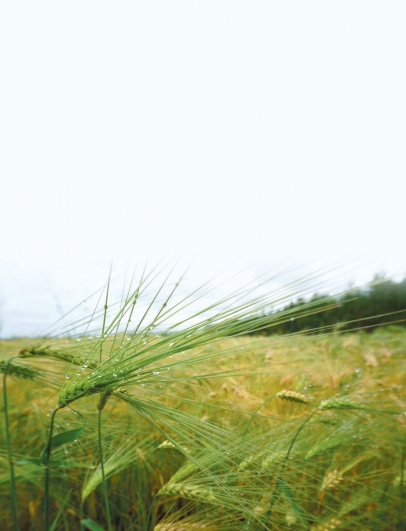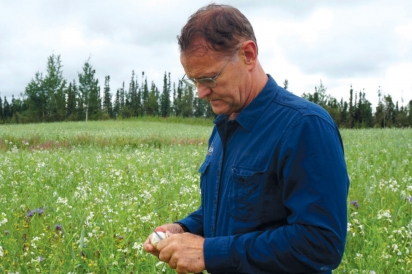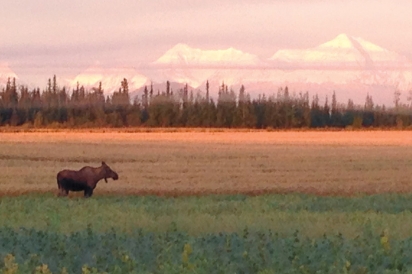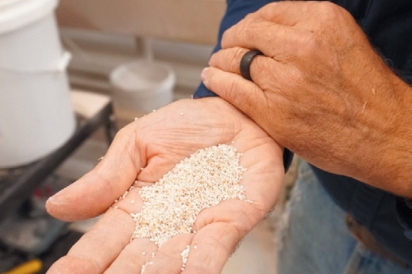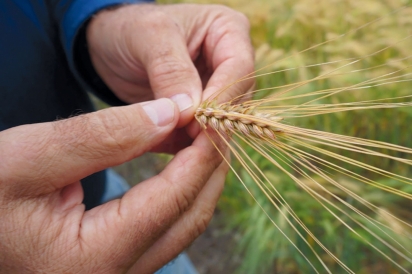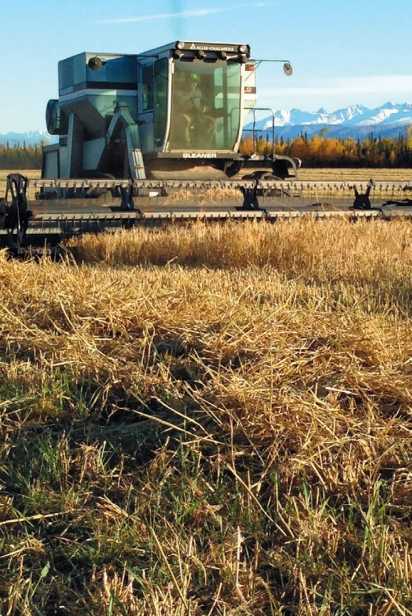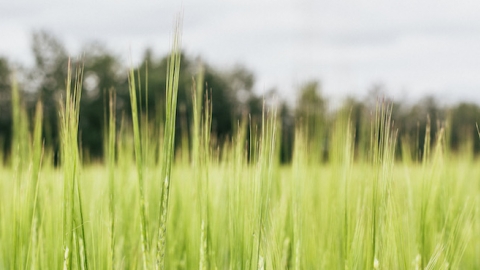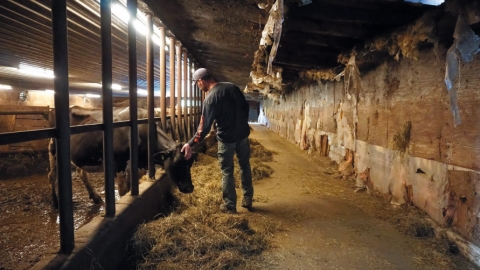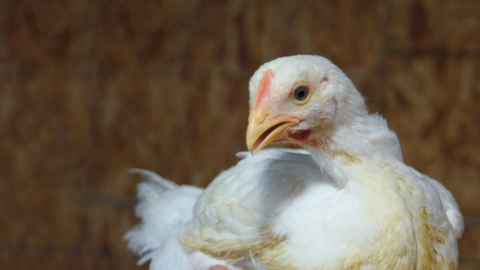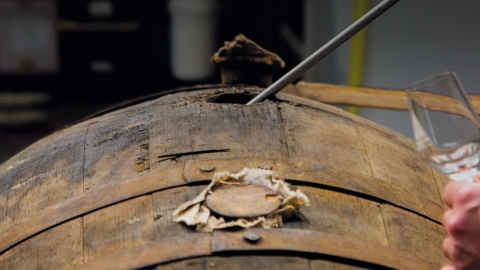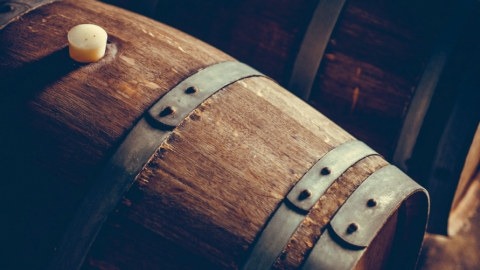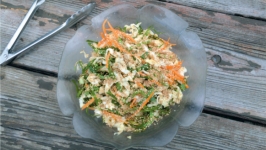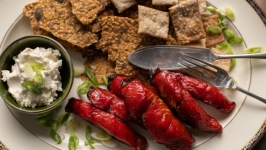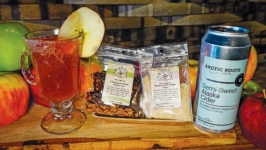How Delta Barley Lives On
A Look Inside Alaska’s Only Commercial Flour Mill
In 1982, Bryce Wrigley read an article in a farming magazine that changed his life.
At the time, he worked on his family’s farm in Idaho, where his ancestors had farmed for generations. They raised sheep and cattle and grew peas and grain. Wrigley was young, enthusiastic, and looking to expand. But he wasn’t the only one in his area looking for land. The other children and grandchildren of generational farmers were looking, too. The market was crowded.
When he read about the Delta Barley Project in Alaska, he saw his opportunity to grow.
“Sometimes you read something, and you just can’t get it out of your mind,” he says. “It just bothered me.”
Wrigley leans against the vinyl siding of his modest, one-story home outside of Delta. He owns Alaska Flour Company now, which runs the only commercial flour mil in Alaska and exports its line of barley-based products across the state and the country. They sell everything from pancake mixes to whole barley. Wrigley is one of the few farmers in Alaska growing grains for human consumption and the only farmer in the country—to his knowledge—with a full line of barley-based products. Food security, family legacy, and new market opportunities motivated him to start the business.
It was a long and sometimes bumpy road to reach those goals. Wrigley gestures toward an old, blue Toyota parked next to lush, green pasture. It’s the vehicle that got him and his dad from Idaho to Alaska in May of 1983. They drove 60 hours straight and stayed a week. They wanted to see if Alaska, swimming in oil revenue and eager to create an agricultural economy, could be their new home. What they saw convinced the Wrigleys to take the plunge. Like so many others, untapped potential drew them north. Bryce and his wife had two small children.
“You leave a lot of stuff behind,” he says. “I’ve got to admire my wife for being willing to do that.”
In the late ’70s, Alaska Governor Jay Hammond chose Delta Junction, where the state owned a large block of land, as the grain-producing heart of an agricultural dream. It would feed a new dairy and livestock industry in the state and create a grain export market. Delta barley was supposed to head south on a train from Fairbanks to a grain terminal in Seward and eventually to Japan. The state lent farmers millions of dollars to buy and clear land.
It was November when Bryce, his family, his parents, and his two youngest siblings moved north. They cut firewood until they established residency, a requirement to qualify for state funds.
“The banks weren’t loaning money for ag, and that hasn’t changed,” Wrigley says.
By the time they got into the business, many farms had been cleared and abandoned. Creating infrastructure and a market for a brand-new industry in a remote place wasn’t easy business. The Seward grain terminal was never built. A few others were, but they were never used as intended. Very little barley was ever exported.
Nowadays, the grain industry in Delta barely resembles the envisioned Delta Barley Project. “It’s a small industry, unfortunately, still a very fragile industry,” says Phil Kaspari, who has known Bryce since the mid-’80s and is the Head of Cooperative Extension for the Delta area.
But the grain industry is alive. According to the 2017 Census of Agriculture for Alaska, 18 farms were growing nearly 5,000 acres of barley in the region. Today, there’s a small cattle industry, and a slaughterhouse due to open a few hours north to serve it. Distilleries have started using Alaskan-grown barley to make alcohol, and a few people are experimenting with growing wheat and other grains. There isn’t the equipment and infrastructure for large-scale, industrial agriculture, but there are fewer pests than in other climates, clean soils, clean water, and room for niche markets.
“The people that hung on here were creative, aggressive—dedicated enough to chisel out some kind of an in-state market,” Kaspari says.
The Wrigleys fit that description perfectly. They raised pigs when the grain market was saturated. They switched back to grain production when the pork market plunged. And when the University of Alaska Fairbanks introduced a barley well-suited for Alaska that could feed people instead of livestock, they took a trip to an out-of-state flour mill and decided to start their own.
“I told my family, if a flour mill is going to happen in Alaska, we should stop waiting on somebody else and get it started,” Wrigley says.
OUT IN THE FIELD
Wrigley rides an orange, diesel-powered side-by-side to a field of cover crops down the road from his house. When he cuts the engine, the sea of delicate blue, yellow, and red flowers hums with life.
“I was out looking [at the field] and became aware of this constant buzz, hum—the flies and the bees, and everything that was out in that field, you know. I just fell in love with that,” he says. “If you go out into a barley field or hay field, you don’t hear that. It’s just quiet.”
Wrigley reaches down, pulls out a turnip, and takes a bite. “It’s so sweet,” he says with a smile. The Wrigleys’ 1,700 acres would feel more like the Midwest than Alaska if it weren’t for the spruce trees dotting the perimeter and the Alaska Range towering in the distance. Bryce says he loves passing through the fields with a tractor, seeing linear progress. He’s practical, organized, and cautious, but not too cautious to try new things.
Wrigley has been experimenting with different varieties of cover crops. He rotates the turnips, radishes, and other nitrogen-fixing crops with fields of barley to reduce the need for fertilizer and increase microbes in the soil. It’s part of a focus on sustainable agriculture.
“Over the years, so many of us have specialized in certain crops, and we’ve gotten away from rotation with animals and grasses and legumes and things like that,” he says. “We’re hoping that people that eat our products will recognize that we’re trying to be as responsible as we can.”
What their customers eat is a few fields down. Bright green stalks of barley are just starting to turn brown. The Sunshine barley that Wrigley grows was developed in 2009. It’s a cross between wheat and barley, but it matures faster than wheat. The difference between it and barley meant for livestock is the hull: it comes off easily when thrashed. And it stays standing when it comes time for harvest, instead of falling to the ground, risking contamination. When it was first introduced, a few farmers experimented with it, but Wrigley is the only one to make a business out of it.
“It’s not as simple as putting a crop in the ground and then combining it and then putting it in a bin and then selling it to somebody for feed,” he says.
Wrigley must have his product inspected, and his flour has to pass a bake test. He also had to build a mill, a line of products, and a market.
Food security motivated the switch. Wrigley worried about what would happen to a remote state like Alaska if the food supply was cut off during a major disaster. He knew grains could provide nutrition on a large scale. “In an emergency, what breaks down society is primarily a fear that they’re going to run out of food,” Wrigley says.
But there’ve been all sorts of other unexpected benefits, like providing a healthy alternative to wheat-based products and getting to work directly with customers.
“It was kind of a selfish reason that I like driving tractors and combines, but when I saw the quality of food that we could grow, there’s a different level of satisfaction when you know you’re producing something that can help people,” Wrigley says. “I’ve become addicted to that.”
Before heading to the mill, there’s one last field to inspect: wheat. The UAF is working on a variety well-suited for Alaska, but it takes time. So far, Bryce hasn’t had much success with what’s available, and and few other farmers in the state have given it a serious try. Palmer’s VanderWeele Farms has grown wheat and rye. VanderWeele currently sells to breweries, at farmers markets, and to an Anchorage bakery on a small scale.
Wrigley feels the season is too short for wheat to mature, but he’s hopeful.
“I want to be in a position where as the summer gets a little warmer or a little longer that we have already found those next crops that are ready for that,” he says.
FROM THE FIELD TO THE KITCHEN
Inside a big, red building, the Wrigleys’ mill spits grain into bins. It smells earthy, and it’s so loud that Bryce and his son Milo Wrigley have to shout to communicate. Milo works quickly as the pneumatically conveyed sifter sorts the grain by size: flour, cereal, and barley couscous. Eventually, the flour will turn into thick, nutty pancakes and barley-flour brownies in their customers’ kitchens.
The mill is impressive. The Wrigleys imported pieces from Denmark and North Carolina. Neither Bryce nor his son is an engineer, but they learned as they went. When they needed a platform, they bought shelves from Costco, turned them upside down, and re-braced them.
“We built this small,” Bryce says. “We didn’t want to lose the farm if we couldn’t pay for it. We figured we could invest this much, and if it fell flat on its face, we could still pay our way out of it.”
They borrowed money from the state’s agriculture revolving loan fund to get started. And they’ve slowly added on since. There were a few flour mills in the state near Fairbanks in the early 1900s, but that was when importing grains was prohibitively expensive. Bryce and his family had to create a model for Alaska from scratch.
They’ve found a market among health-conscious consumers and the local food movement. Barley has a lower level of gluten and more fiber than wheat. And he thinks there’s room for growth, inside the state and out. He has his eyes on Japan and Taiwan as potential markets. And Wrigley wants other farmers to join him.
“We have the capacity to mill a lot more here than what we’re doing,” Wrigley says. “I’d like to get to a point that I’m contracting that growth. It spreads our risk… I think it adds resiliency to the food system and to us.”
It’s a dream he has, to bring Delta’s agricultural community closer together. He wants farmers to learn from each other and help each other succeed. But he has to prove that his model is working. And he has to convince consumers to step out of their comfort zone and try something new, like a barley pancake.
This story was originally published in the Winter, 2019 issue of Edible Alaska.


